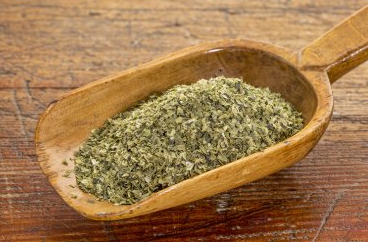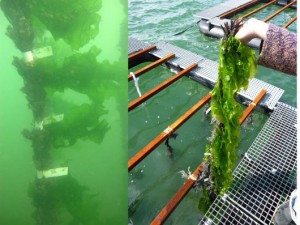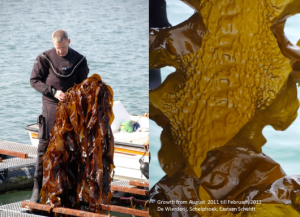 Most people are familiar with seaweed as the smooth green sheet used to make sushi rolls. This large saltwater plant is used extensively in food preparation, particularly for Asian dishes. But in addition to China, where more than half of seaweed crops are grown, opportunities are also prevalent in the Netherlands for seaweed cultivation and new products. A collaborative venture between leading institutes will be exploring the contours of a sustainable seaweed chain this year.
Most people are familiar with seaweed as the smooth green sheet used to make sushi rolls. This large saltwater plant is used extensively in food preparation, particularly for Asian dishes. But in addition to China, where more than half of seaweed crops are grown, opportunities are also prevalent in the Netherlands for seaweed cultivation and new products. A collaborative venture between leading institutes will be exploring the contours of a sustainable seaweed chain this year.
Large-scale partnership
 ‘The whole world is talking about seaweed, but no major company has invested in it yet. We’re going to change that.’ Project Leader Floris Groenendijk from IMARES Wageningen UR has a clear vision. ‘In a seaweed chain that covers the cultivation, harvesting, processing and sale of products, we are going to explore what types of new, promising products can be produced from seaweed.’
‘The whole world is talking about seaweed, but no major company has invested in it yet. We’re going to change that.’ Project Leader Floris Groenendijk from IMARES Wageningen UR has a clear vision. ‘In a seaweed chain that covers the cultivation, harvesting, processing and sale of products, we are going to explore what types of new, promising products can be produced from seaweed.’
After all, this saltwater plant is packed with proteins, carbohydrates, fatty acids and vitamins. Seaweed crops could therefore serve more markets than the food sector alone. ‘The possibilities also include animal feed, chemicals and semi-manufactured products for the chemical industry and energy sector,’ says Groenendijk. ‘But there needs to be a market.’
With a budget of 850,000 euros from the Ministry of Economic Affairs, the collaborative venture between knowledge institutions in the water sector will prepare a brief outline of the new form of ‘agriculture at sea’.
Apart from various Wageningen UR institutes, knowledge institutions Marin, Deltares, ECN and TNO are also taking part in this project. Their goal is to entice a large number of companies to invest in the venture. ‘An interesting new product like seaweed cheese, seaweed soap or semi-finished products for the chemical industry can make this even more appealing,’ hopes Groenendijk.
Agriculture at sea

More than four years of experience in the ‘Wierderij’ seaweed farm in the Oosterschelde has taught that seaweed can be grown year round with a dry matter yield of 25 tonnes per hectare per year. ‘This type of mariculture fits in well with the Netherlands’ agricultural exploits,’ states Willem Brandenburg from Wageningen UR with pride. Brandenburg has been convinced of the benefits of saltwater crops, especially seaweed, for years.
‘Agriculture at sea can produce sufficient proteins to attain ambitious goals, such as achieving twice as much production with half as much impact on the environment and raw materials, and consequently feed nine billion people in the future,’ he says. ‘That’s simply not possible on land.’
Moreover, a number of cycles can be closed at sea, such as the cycle of minerals washed out to sea from land, e.g. phosphate, trace elements like copper, nutrients like nitrogen and the abundance of carbon in the form of CO2,’ he summarises. The supply of nutrients makes deltas perfect for mariculture.
With its sophisticated photosynthesis process in a 100% salt environment, rapidly growing seaweed in particular can produce proteins in several layers in the water. ‘Considering the results achieved thus far, we believe that with a surface area around four times the size of Portugal, enough protein can be produced at sea to feed the entire world population,’ says Brandenburg.
Incontinence materials and bioplastics
But seaweed is more than just a source of human and animal feed. Alginate from brown seaweed and carrageen from red seaweed are known polysaccharides that are used for such things as wound dressings and as a thickening agent and stabiliser in foodstuffs like custard, explains Paulien Harmsen from Wageningen UR Food & Biobased Research. ‘We want to study whether these hydrocolloids can be used for other purposes as well. Their moisture-retaining properties, for example, make them suitable for use in incontinence materials and other types of bioplastics,’ adds Harmsen. ‘Seaweed can also provide building blocks for the chemical and pharmaceutical industries, such as mannitol is used as a building block for polyesters.’
In addition to growing seaweed in, for example, the North Sea, Harmsen believes that the residual waste flows from seaweed production in countries like France and Norway can also be of interest. ‘For the current applications in foodstuffs, only one-fourth of the biomass is used. The remaining three-fourths are “waste”, but waste that is absolutely brimming with valuable components,’ says Harmsen.
Towering waves
There is still quite a bit of work to be done before large-scale seaweed farms are a reality. Knowledge institutions Marin and Deltares will be determining the types of constructions that are needed to make seaweed cultivation able to withstand the rough sea environment, with waves that can reach over twenty metres during a winter storm. On the current small pilot scale, researchers harvest the seaweed manually on their knees, but harvesting machines are absolutely essential for commercial cultivation on hundreds of hectares. The link between offshore technology and agricultural technology is evident, but still needs to be fleshed out. The consortium plans to do just that.
Transport of the ‘fields’ of seaweed from sea to land requires a smart approach. A combination with trawlers, or even drilling platforms and windmill parks, is the interesting topic of challenging research. Spatial planning at sea, including the governance of all users on the already crowded North Sea, is also a topic of research.
After all, the researchers emphasise, the seaweed chain should above all be sustainable. ‘That is not only a question of environmentally friendly cultivation, but also societal acceptance and profitability,’ explains Willem Brandenburg. It must fit in with the sea landscape and preferably also offer new opportunities for nature. But a start has been made. ‘At our seaweed farm in the Oosterschelde, we are neighbours with a colony of Sandwich terns in a Natura 2000 area, fish can relax with the seaweed under our decking and we are often visited by a local seal, whom we like to consider our pet.’
Contact
IMARES Wageningen UR
drs. FC (Floris) Groenendijk
Source
Wageningen UR, press release, 2015-03-09.
Supplier
Deltares (NL)
Dutch Ministry of Economic Affairs
Energy research Centre of the Netherlands (ECN)
Marin - Maritime Research Institute Netherlands
TNO
Wageningen University
Share
Renewable Carbon News – Daily Newsletter
Subscribe to our daily email newsletter – the world's leading newsletter on renewable materials and chemicals










